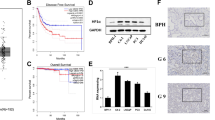Abstract
Prostate cancer is the most common type of solid tumor and a leading cause of cancer-related death of men living in the developed world. In recent years, the molecular mechanisms involved in prostate cancer development and/or progression have been intensely studied and several genes have been identified. TGIFLX/Y (TGIFLX and TGIFLY) are members of the homeobox superfamily of genes whose function(s) is unknown. To investigate TGIFLX/Y mRNA expression in prostate cancer, we studied two different types of clinical samples, namely 60 prostate tumors and 15 cases of benign prostate hyperplasia (BPH), by RT-PCR. Our results revealed that most prostate tumors (73.5%) express at least one of these genes, although different patterns of TGIFLX/Y mRNA expression were observed. In some tumor samples the expression of both genes was detected, while in others no expression of either gene was observed. Notably, there was a significant correlation between expression of both TGIFLX and TGIFLY and a Gleason score of ≥6 (P = 0.038). By contrast, expression of TGIFLX/Y mRNA in BPH samples could not be detected. These results suggest an association of TGIFLX/Y expression with the progression of prostate cancer.


Similar content being viewed by others
References
Landis SH, Murray T, Bolden S, Wingo PA. Cancer statistics, 1998. CA Cancer J Clin. 1998;48:6–29. doi:10.3322/canjclin.48.1.6.
Berthelsen J, Zappavigna V, Ferretti E, Mavilio F, Blasi F. The novel homeoprotein Prep1 modulates Pbx-Hox protein cooperativity. EMBO J. 1998;17:1434–45. doi:10.1093/emboj/17.5.1434.
Jacobs Y, Schnabel CA, Cleary ML. Trimeric association of Hox and TALE homeodomain proteins mediates Hoxb2 hindbrain enhancer activity. Mol Cell Biol. 1999;19:5134–42.
Kamps MP, Murre C, Sun XH, Baltimore D. A new homeobox gene contributes the DNA binding domain of the t(1;19) translocation protein in pre-B ALL. Cell. 1990;60:547–55. doi:10.1016/0092-8674(90)90658-2.
Argiropoulos B, Humphries RK. Hox genes in hematopoiesis and leukemogenesis. Oncogene. 2007;26:6766–76. doi:10.1038/sj.onc.1210760.
Yu YY, Pan YS, Zhu ZG. Homeobox genes and their functions on development and neoplasm in gastrointestinal tract. Eur J Surg Oncol. 2007;33:129–32. doi:10.1016/j.ejso.2006.09.010.
Wigle JT, Eisenstat DD. Homeobox genes in vertebrate forebrain development and disease. Clin Genet. 2008;73:212–26.
Banerjee-Basu S, Baxevanis AD. Molecular evolution of the homeodomain family of transcription factors. Nucleic Acids Res. 2001;29:3258–69. doi:10.1093/nar/29.15.3258.
Bertolino E, Reimund B, Wildt-Perinic D, Clerc RG. A novel homeobox protein which recognizes a TGT core and functionally interferes with a retinoid-responsive motif. J Biol Chem. 1995;270:31178–88. doi:10.1074/jbc.270.52.31178.
Burglin TR. Analysis of TALE superclass homeobox genes (MEIS, PBC, KNOX, Iroquois, TGIF) reveals a novel domain conserved between plants and animals. Nucleic Acids Res. 1997;25:4173–80. doi:10.1093/nar/25.21.4173.
Imoto I, Pimkhaokham A, Watanabe T, Saito-Ohara F, Soeda E, Inazawa J. Amplification and overexpression of TGIF2, a novel homeobox gene of the TALE superclass, in ovarian cancer cell lines. Biochem Biophys Res Commun. 2000;276:264–70. doi:10.1006/bbrc.2000.3449.
Jin L, Zhou Y, Kuang C, Lin L, Chen Y. Expression pattern of TG-interacting factor 2 during mouse development. Gene Expr Patterns. 2005;5:457–62.
Blanco-Arias P, Sargent CA, Affara NA. The human-specific Yp11.2/Xq21.3 homology block encodes a potentially functional testis-specific TGIF-like retroposon. Mamm Genome. 2002;13:463–8. doi:10.1007/s00335-002-3010-9.
Aarabi M, Ousati-Ashtiani Z, Nazarian A, Modarressi MH, Heidari M. Association of TGIFLX/Y mRNA expression with azoospermia in infertile men. Mol Reprod Dev 2008.
Magi-Galluzzi C, Xu X, Hlatky L, Hahnfeldt P, Kaplan I, Hsiao P, et al. Heterogeneity of androgen receptor content in advanced prostate cancer. Mod Pathol. 1997;10:839–45.
Suarez BK, Gerhard DS, Lin J, Haberer B, Nguyen L, Kesterson NK, et al. Polymorphisms in the prostate cancer susceptibility gene HPC2/ELAC2 in multiplex families and healthy controls. Cancer Res. 2001;61:4982–4.
Hsu Y-S, Wang J-S, Wu TT. E-cadherin expression in prostate adenocarcinomas in Chinese and its pathological correlates. Urol Int. 2004;73:36–40. doi:10.1159/000078802.
Jemal A, Siegel R, Ward E, Hao Y, Xu J, Murray T, et al. Cancer statistics, 2008. CA Cancer J Clin. 2008;58:71–96.
Waltregny D, Alami Y, Clausse N, de Leval J, Castronovo V. Overexpression of the homeobox gene HOXC8 in human prostate cancer correlates with loss of tumor differentiation. Prostate. 2002;50:162–9. doi:10.1002/pros.10045.
Miller GJ, Miller HL, van Bokhoven A, Lambert JR, Werahera PN, Schirripa O, et al. Aberrant HOXC expression accompanies the malignant phenotype in human prostate. Cancer Res. 2003;63:5879–88.
Ouyang X, DeWeese TL, Nelson WG, Abate-Shen C. Loss-of-function of Nkx3.1 promotes increased oxidative damage in prostate carcinogenesis. Cancer Res. 2005;65:6773–9. doi:10.1158/0008-5472.CAN-05-1948.
Crijns APG, de Graeff P, Geerts D, Ten Hoor KA, Hollema H, van der Sluis T, et al. MEIS and PBX homeobox proteins in ovarian cancer. Eur J Cancer. 2007;43:2495–505. doi:10.1016/j.ejca.2007.08.025.
Wong P, Iwasaki M, Somervaille TCP, So CWE, So CWE, Cleary ML. Meis1 is an essential and rate-limiting regulator of MLL leukemia stem cell potential. Genes Dev. 2007;21:2762–74. doi:10.1101/gad.1602107.
Richmond PJ, Karayiannakis AJ, Nagafuchi A, Kaisary AV, Pignatelli M. Aberrant E-cadherin and alpha-catenin expression in prostate cancer: correlation with patient survival. Cancer Res. 1997;57:3189–93.
Guan M, Chen Y. Aberrant expression of DeltaNp73 in benign and malignant tumours of the prostate: correlation with Gleason score. J Clin Pathol. 2005;58:1175–9. doi:10.1136/jcp. 2005.026955.
Lappin TRJ, Grier DG, Thompson A, Halliday HL. HOX genes: seductive science, mysterious mechanisms. Ulster Med J. 2006;75:23–31.
Grier DG, Thompson A, Kwasniewska A, McGonigle GJ, Halliday HL, Lappin TR. The pathophysiology of HOX genes and their role in cancer. J Pathol. 2005;205:154–71. doi:10.1002/path.1710.
Wang Z, Mann RS. Requirement for two nearly identical TGIF-related homeobox genes in Drosophila spermatogenesis. Development. 2003;130:2853–65. doi:10.1242/dev.00510.
Acknowledgments
We thank Ms. S. Moradkhani and Ms. M. Rezaie for their kind efforts in collecting the prostate samples and datasheets, Dr N. Pouladi for his advice on statistical analysis. This project was supported by a grant from the Tehran University of Medical Sciences.
Author information
Authors and Affiliations
Corresponding author
Rights and permissions
About this article
Cite this article
Ousati Ashtiani, Z., Ayati, M., Modarresi, M.H. et al. Association of TGIFLX/Y mRNA expression with prostate cancer. Med Oncol 26, 73–77 (2009). https://doi.org/10.1007/s12032-008-9086-7
Received:
Accepted:
Published:
Issue Date:
DOI: https://doi.org/10.1007/s12032-008-9086-7




